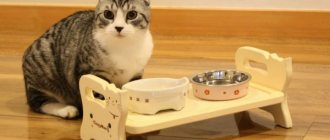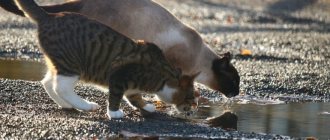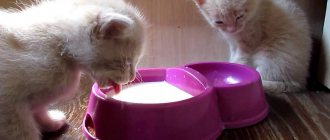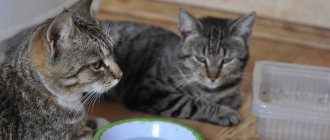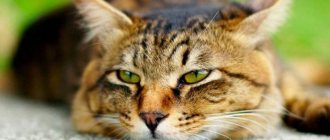How old is your pet?
Ten? More? Then this is definitely the place for you! Because after 8-10 years, various age-related changes begin to occur in the cat’s body, which you need to be aware of and take into account. May your four-legged pet live happily ever after! By the way, previously the age limit for our pets was much lower - 12-year-old cats were considered long-livers. It was man who raised the quality of life, and with it its duration, by one and a half to two times.
And now it is easy to meet cats that have reached 16-19 years of age, or even more. For example, in our clinic we see two cats, each 21 years old, and the most significant thing that worries them is their teeth, or rather, tartar, which is removed from them from time to time.
Well, the age of cats from the Guinness Book of Records generally exceeds the 30-year mark.
So, among pets, the number of “elderly” pets (approximately 30%) who need optimal care is increasing.
It’s a fact that as the number of years you live increases, everything changes (and not only for cats :-)). Age-related changes affect all body functions. For now, we will consider only behavioral ones.
The causes of behavioral changes can be a number of diseases (including systemic ones) acquired by the animal over the years of its life, brain pathologies, as well as CDS - cognitive dysfunction syndrome. First, let's look at medical ailments, and then move on to the most interesting part.
Osteoarthritis (joint disease) can occur in 65% of cats over 12 years of age (the elbow and hip joints are most commonly affected, and the knee and shoulder are less common). Joint pain leads to decreased mobility and the appearance of aggressiveness when communicating with people and other animals.
Systemic hypertension (high blood pressure) often causes a pet to scream at night, disorientate in space, lose consciousness, meaningless circular movements and even seizures.
Chronic kidney disease most strongly influences behavior changes: polyuria (increased urine volume) leads to urination in the wrong places, and with a lack of water, dehydration of brain tissue. Polydipsia (increased thirst) causes cats to drink from containers that are not intended for this purpose. The development of acidosis (increased body acidity) causes weight loss and drowsiness. And severe uremia (self-poisoning of the body with nitrogenous waste from urine) leads to uremic encephalopathy, a non-inflammatory disease of the brain. In addition, kidney disease is often accompanied by hypertension (see above).
Hyperthyroidism (increased thyroid hormones) leads to the same consequences as chronic renal failure. In addition, it affects the concentration of thyroxine in the brain (manifests as anxiety and aggressiveness), causes polyphagia - the cat’s taste and appetite change.
Diabetes mellitus has the same consequences as chronic renal failure and hyperthyroidism. In addition, it can cause sensory or motor neuropathies (irritability, increased sensitivity to external influences (touch), muscle pain).
Urinary tract infections cause pain and discomfort in your pet's bladder or kidneys. The result is “incorrect” urination, anxiety, aggression, and depression.
Changes in appetite, weight loss, gastrointestinal diseases , which appear due to physiological changes and pathological processes, are associated with a deterioration in the sense of smell and taste, pain in the oral cavity, for example, due to periodontal disease.
Loss of Hearing and Vision Cats quickly adapt to blindness. With deafness the situation is worse. Cats with poor hearing begin to make loud noises (possibly at night) because they have difficulty hearing their voices.
Brain tumors are more common in older cats (11 years of age and up). Meningioma, lymphoma, glioma, pituitary tumors are expressed by restlessness, circular movements and convulsions.
Pain , especially constant pain, greatly debilitates the animal. Chronic pain most often occurs with artiritis, as well as with inflammatory processes in other organs, for example, with periodontal disease and diseases of the digestive tract (obstruction). Cats, due to their evolutionary development, are able to cope even with severe pain.
Infectious diseases (viral immunodeficiency, viral leukemia, infectious peritonitis, toxoplasmosis) cause neurological disorders and, consequently, behavioral changes.
So, there are many medical reasons for behavioral problems in older cats. And identifying them often requires a number of diagnostic studies. But if diseases are excluded, that is, when there is no obvious cause, then it is believed that the animal’s behavior changes under the influence of cognitive dysfunction syndrome (CDS)
Alzheimer's? In cats?!
Yeah, something like that. Everything is like the big ones.
In cats with cognitive dysfunction syndrome, changes occur in the brain that lead to decreased mental abilities. This affects the processes of thinking, memory, learning new things, and using acquired skills.
Cognitive dysfunction syndrome is a progressive disease with increasing signs of aging behavior
A third of 11-14 year old cats have at least one of the behavioral disorders caused by CDS, and in 15 year old cats the number of such problems is no less than 50%.
The most striking symptom of cognitive dysfunction is disorientation. The cat seems to get lost in the apartment, hides in a corner or under furniture, bumps into door frames in an attempt to find the door, does not recognize the owners or other animals, and does not respond to calls.
The sleep-wake pattern is often disrupted (as a rule, the cat sleeps more during the day and much less at night).
The proportion of purposeful actions decreases and the frequency of aimless wandering increases. There may be movements in a circle or involuntary oscillatory movements - tremor, or, conversely, immobility, weakness.
An older cat may go potty less often and go to inappropriate places more often.
The quality of communication with the owners deteriorates, the animal asks for less and less affection and attention.
Physiological causes of cat weight loss
Weight loss in a cat is influenced by the conditions under which the animal is kept (hygienic, psychological), changes in the animal’s hormonal status depending on the season of the year, and the animal’s character (picky eating).
Seasonal changes
During the mating period, cats and female cats, especially those who go outside freely, may, as a result of sexual dominance, forget about food and lose weight. This condition does not require correction. After a period of “walking,” the body shape of cats and kittens is restored.
External seasonal changes in ambient temperature
When the temperature in the room in which the cat is kept decreases or if animals roam freely outside in winter, cats and cats gain their live weight. In the spring, with warming and increasing physical activity, especially during the period of “festivities,” the animal’s fats are absorbed. This is normal for cats and dogs.
Stress in a cat
Cats by nature are big conservatives. Any change in their usual environment and daily routine can cause them stress. Home renovations, the arrival of guests, a change in diet, the appearance of a new pet in the apartment (a puppy, for example) or the birth of a child can lead to nervousness, as a result of which the cat will eat less and lose weight.
Pregnancy and feeding kittens
Nursing cats have a good appetite, but often lose weight when nursing kittens. If a cat has a lot of kittens, she is not able to eat as much food as is required to cover the cat’s costs of producing milk. As a result, the cat uses up its body reserves to produce milk and looks emaciated. The cat will become rounder when the feeding process is completed.
Features of age
Young active cats and cats that move a lot cannot maintain the curvaceous shape of their body. Old age - Older cats require less energy, move less and sleep a lot. Often they just don't eat enough. Exhaustion in an older cat may be associated with health problems, so an old cat that is losing weight should be shown to a veterinarian as soon as possible.
The reason why the cat suddenly began to lose weight may be simple malnutrition of the food offered or a lack of animal food in the offered diet. A cat by nature is a predator, like other predatory animals, and needs food of animal origin. Therefore, you will not be able to put your cat on the vegetarian diet that is fashionable today. A cat can also lose weight due to the fact that the new food offered to it does not like the taste.
The pathological cause of unexpected weight loss in a cat can be:
Oral problems.
The most common condition in cats is stomatitis, an inflammation of the oral mucosa. When stomatitis occurs in a cat, the gums, palate, lips and tongue are affected.
Causes of stomatitis in cats.
Primary stomatitis in cats can occur as a result of:
- Irritation and damage to the oral mucosa from rough, sharp and caustic food, foreign bodies, teething.
- Thermal irritants (feeding very hot or cold food). Chemicals (irritating drugs, poisons, household chemicals, etc.).
Secondary stomatitis in a cat can be a consequence of:
- Infectious diseases (feline panleukopemia, infectious rhinotracheitis, calcevirus infection in cats, leptospirosis, chlamydia in cats, foot and mouth disease).
- Diseases of the digestive system and liver.
- Food allergies.
- Metabolic diseases and hypovitaminosis.
Signs of stomatitis in cats
Signs of stomatitis in a cat largely depend on the inflammatory process in the oral cavity (catarrhal, ulcerative, vesicular, pustular, aphthous, diphthyritic, gangrenous). In all forms of stomatitis, a cat has a disturbance in the act of chewing. When eating, cats choose the softest food, chew carefully, slowly with pauses. Stomatitis in a cat usually begins with catarrhal inflammation of the oral mucosa and is accompanied by:
Increased salivation. Increased thirst. Chew carefully while eating. When examining the oral cavity, the mucous membrane is very red, dry and swollen. Swelling of the mucous membrane causes difficulty in the outflow of blood from the venous sinuses of the hard palate and leads to venous stagnation. Thickened ridges of the hard palate hang into the oral cavity. Swelling of the mucous membrane of the lips, cheeks and gums is mild. For more information about stomatitis, see our article - stomatitis in cats.
Dental diseases (tartar in cats, dental caries, periodontitis, various anomalies in the development of teeth). The cat may feel hungry, but due to great pain when chewing, it may not eat (the cat approaches the plate, sniffs the food, tries to eat, then leaves), as a result of which it loses weight. Owners often notice that cats with dental diseases have an unpleasant odor from the oral cavity and increased salivation (the cat is drooling).
Ways to force a kitten to eat
Sometimes it is more convenient to inject food into the animal with a syringe. If your pet refuses to eat for several days after illness, then it is necessary to forcefully feed the sick cat. It is worth contacting a veterinary clinic, where they will conduct laboratory and instrumental examinations, assess the condition of the animal and select the necessary food or other food products. There are several ways to feed a cat after illness:
- On the gums. You should spread a tasty treat that may give the kitten an appetite.
- Through a pipette or syringe. In this way, it is possible to feed a weakened cat liquid food. The corner of the feeding aid is directed towards the molars. For the first time, 30 grams of milk or chicken broth is enough. If after taking liquid food there is no vomiting, then the procedure is repeated, increasing the dosage of food.
- At the root of the tongue. Calm the cat and place it on the left hand, as if holding a child. A small piece of meat, fish or liver is placed on the tongue and the cat’s mouth is closed, tightly fixing the jaw. It is recommended to pat your pet's throat to help him swallow food faster.
- Warming up food before eating. If, after an illness, a cat refuses to eat due to a runny nose, this may be due to a lack of sense of smell. To eliminate the problem, you need to reheat the food before serving so that it releases pleasant aromas. In this case, the pet is more likely to smell the food and eat it.
Recommendations for owners
A pipette can be useful if the animal does not want to drink on its own. Owners should be patient, since during and after an illness it is often necessary to force-feed the cat for a long time until complete recovery and recovery
It is equally important to provide your pet with 24-hour access to water, and you can also give him liquid on an empty stomach to increase his appetite. If you refuse to drink, use a pipette and forcefully pour liquid into the cat’s body after illness.
Cat worm disease
Worms or helminthic diseases are most common among cats. Owners of their pets should clearly understand that helminthic diseases can occur even if your pets have not left your apartment. They can become infected with existing parasitic worms through eggs of various helminth infections brought from the street on the soles of their shoes. Cats during walks, in close contact with the environment, expose themselves to the danger of becoming infected with helminth eggs, which are found in large numbers on various objects. A particularly great danger in this regard is provided by the direct contact of your cat with other homeless, stray animals. Being essentially predators, cats never refuse raw fish or meat offered to them, which in our time of market relations can be infected with helminthic infestation. Some types of worms cause characteristic, pronounced symptoms of helminthic disease. With severe infestation, the cat loses a lot of weight, even with a good appetite. A sick cat vomits (vomiting in cats), sometimes with blood, and gastrointestinal tract disorder (diarrhea) appears (diarrhea in cats). Kittens infected in utero may die from blockage or rupture of the small intestine. In young cats we note anemia and gastrointestinal disorders. Other worms, hiding in the muscles or liver of a cat for a long period of time, do not show themselves in any way. Taking into account the above, cat owners need to carry out preventive deworming with anthelmintic drugs. For more information about worms, see our article - worms in cats.
Cat affected by ectoparasites. Very often, our cats suffer from diseases that are caused by various parasites that live both outside and inside the animal’s body. Ectoparasites—fleas, lice, and ticks—settle on the skin of cats.
Fleas are wingless insects with a body flattened on the sides. Only adult individuals parasitize the body of cats; the larvae live in the environment. Fleas are extremely prolific - each female lays 25 eggs daily, which fall down, accumulating on the litter, in the cracks of wooden floors, on carpets, etc. After hatching from the eggs, the larvae, after going through a series of changes, turn into adults, which, when they meet a cat, settle in her fur and switch to a parasitic lifestyle. They bite him and drink his blood; as a result of severe flea infestation, the cat loses weight. The presence of fleas in an animal can be indicated by the presence of small black crumbs on the cat’s body.
Oncological diseases. Like other types of domestic animals, cats are prone to cancer. Moreover, the majority of neoplasms identified in cats are malignant in nature, so this pathology requires complex treatment in a modern veterinary clinic by an experienced veterinary specialist.
A malignant tumor in a cat occurs as a result of a malfunction of DNA molecules, which are a repository of information and are present in every cell of the cat.
A malignant tumor, as it grows, increases in size and begins to grow into the healthy tissue of the affected organs, causing inhibition of their function.
The clinical picture of cancer in a cat depends on the organ affected by cancer, the stage of the disease and the general condition of the cat. For many years, the neoplasm in a cat cannot be externally manifested in any way. Symptoms of the disease in an animal may be vague and unclear.
In cases of liver cancer, veterinary specialists note general weakness, fatigue, decreased appetite in a cat, a change in the consistency and color of feces, and a sharp decrease in weight. The cat begins to develop jaundice (visible mucous membranes, the cornea of the eyes and the skin acquire a yellowish tint). Disease symptoms characteristic of liver disease in cats appear.
Stomach cancer in cats. During a clinical examination, the veterinarian notes that the cat has general weakness, drowsiness, poor appetite, and a painful abdomen on palpation. Increased body temperature. There is a change in the color and consistency of fecal matter, sometimes we find blood clots in the fecal matter, the cat suddenly loses weight, and anemia develops.
Bowel cancer. During a clinical examination, a veterinarian finds the same clinical signs in a sick cat as for stomach cancer. Unlike stomach cancer, fresh, scarlet blood appears in the stool, a foul odor emanates from the feces, and bloating occurs. A fetid odor is felt from the oral cavity, and rumbling sounds are heard on auscultation of the intestines. Depending on the affected part of the intestine, there may be diarrhea (diarrhea in a cat) or, on the contrary, constipation (constipation in a cat (coprostasis).
For more information about oncological diseases in cats, see our article - oncology in cats.
Infectious diseases
Infectious diseases in cats are caused by a variety of bacteria and viruses, in which the animal’s body experiences loss of body weight (weight loss) due to loss of appetite and disorders of the gastrointestinal tract. The most common infectious diseases of cats include - (infectious rhinotracheitis in cats, chlamydia in cats, mycoplasmosis in cats, bordetellosis in cats, calcivirus infection in cats, panleukopenia in cats, infectious peritonitis in cats).
Internal non-communicable diseases
Almost all diseases accompanied by loss of appetite and even the entry of a foreign object into the stomach can lead to weight loss.
Common internal non-contagious diseases in cats include:
Kidney stones in cats or urolithiasis is a chronic disease of cats in which stones and urinary sand (urolithiasis) form in the urinary tract of animals. Urolithiasis (UCD) is a chronic disease associated with metabolic disorders and accompanied in a cat by the formation and deposition of urinary stones, different in chemical composition, or sand in the renal pelvis, urinary ducts, bladder, urethra and leading to disruption of natural outflow urine.
Symptoms of the disease. If a cat’s kidney stones are small and there is no blockage in the urinary tract, then the cat’s disease occurs without obvious clinical signs, but the results of laboratory tests of urine and blood indicate its occurrence. During such a latent period of the course of urolithiasis, symptoms can be detected in a cat that not only indicate its development, but also allow a veterinarian to determine the location of the urolithiasis. The cat's owners notice a decrease in appetite, drowsiness, and depression. When a stone forms in the renal pelvis, a cat develops symptoms characteristic of pyelitis. Owners sometimes find blood in their cat's urine (hematuria), especially after active movements of the cat. The presence of stones in the cat's bladder is manifested by frequent urge to urinate and restlessness. In the case when a kidney stone begins to move along the ureter and causes its blockage, we observe ureteral obstruction. With partial obstruction of the ureters, owners note difficulty urinating in the cat. Urination becomes strained, and the cat sometimes cries while peeing. The cat's urination becomes frequent with the release of a small amount of urine; upon careful examination, blood can be detected in the urine. Additionally, the owners note a lack of appetite in the cat, vomiting, and the abdominal area becomes painful upon palpation.
For treatment and prevention of this widespread disease in cats, see our article - Kidney stones in cats or urolithiasis.
Liver diseases – Hepatitis is the general name for inflammatory diseases of the liver tissue. Hepatitis often occurs simultaneously with diseases of the stomach, intestines, pancreas and other organs. With hepatitis, the gallbladder and bile ducts are almost always involved in the process. Hepatitis is accompanied by profound disturbances in protein, carbohydrate-fat and pigment metabolism, and liver cells disintegrate.
Cirrhosis of the liver - in a cat, it is accompanied by a change in the liver’s structure due to the growth of connective tissue in the liver.
Liver failure is a severe pathological condition of an animal in which liver function is impaired. Liver failure in cats can occur in acute and chronic forms.
Main symptoms of liver disease in cats.
Liver disease in cats is characterized by a number of signs that should alert its owner. An owner can suspect liver disease in their cat based on the following symptoms:
Vomiting in a cat. Cat has diarrhea. Jaundice, in which icteric staining of the mucous membranes and subcutaneous tissue occurs in a yellow color. Skin itching. Change in urine color, from yellow to brown. Change in color of feces from brown to gray or brown. Abdominal dropsy, ascites - an increase in the volume of the abdomen due to the accumulation of fluid in the abdominal cavity. An increase in the size of the liver, which manifests itself as a protrusion through the abdominal wall. Pain in the liver area (hepatic colic). Multiple hemorrhages in the skin and subcutaneous tissue. Poor blood clotting.
A number of endocrine diseases - problems with the thyroid gland, diabetes (even cats are susceptible to this insidious disease) are certainly accompanied by weight loss even with an increased, and sometimes perverted, appetite.
Diseases of the digestive system lead to a cat’s weight loss, even while maintaining the same amount of food eaten.
When you urgently need to see a doctor
Even if an apparently healthy cat does not eat or drink anything, has become passive or is showing anxiety, it is necessary to show it to a doctor, even for preventive purposes. But there are a number of symptoms for which a visit to the clinic should be urgent.
First of all, it is a dry nose. Any changes in temperature are also an alarm bell. You should also see a doctor if you experience the following symptoms:
- sharp pain when touched;
- plaintive cries;
- severe oppression of the animal;
- fever;
- vomit;
- severe diarrhea.
Any of these signs in itself is already a reason to worry, and if, at the same time, the cat does not eat anything, then it is better not to postpone a trip to the veterinary clinic.
Diagnosis of the causes of exhaustion in a cat
Based on the fact that there are a large number of reasons that can cause exhaustion in a cat, the owners of an exhausted cat will need to contact a veterinarian at their veterinary clinic. Veterinary specialists will conduct a clinical examination of your cat and collect a medical history.
- In order to exclude helminthic diseases, feces will be taken for examination in a veterinary laboratory for worms.
- To exclude inflammatory processes and anemia in the cat, a complete clinical blood test will be performed.
- A complete biochemical blood test will be performed to determine the functioning of the liver, kidneys, protein and sugar levels in the blood.
- A urine test will allow your veterinarian to evaluate kidney function, look for protein in the urine, and sometimes detect infection.
- In order to exclude oncological diseases, the presence of foreign bodies in the gastrointestinal tract, fluid in the chest and abdominal cavity, an X-ray of the chest and abdominal cavity will be taken.
- Using an ultrasound of the abdominal cavity, a study of the liver, kidneys, pancreas, and the functional state of the intestines will be performed.
- Your older cat will have your thyroid hormone levels measured.
- Bile acid levels will be measured to assess liver function.
Ready-made feed
Some cat food manufacturers offer special options for weight gain and malnutrition. This food is characterized by a high content of fats and proteins, useful substances that will help the animal recover faster. The paste-like consistency makes it easier for your cat to eat its food. A lot of energy will not be spent on digesting special medicinal food.
High-protein foods are another option for quickly gaining weight for an overly thin cat. To get the maximum effect from such food, make sure that the protein source is listed first in the composition - rabbit, chicken, beef, etc. It’s good if the composition contains a source of taurine.
Along with ready-made food, a weakened cat can be supported with biologically active and vitamin supplements, but only after consultation with a veterinarian.


